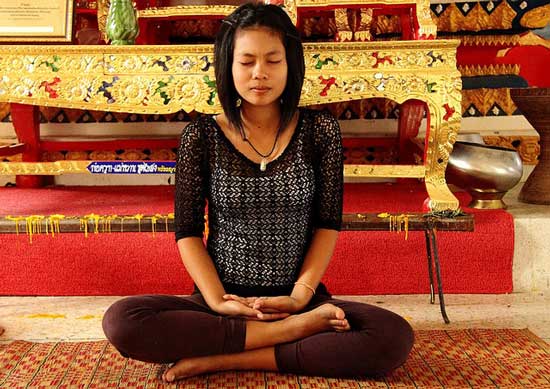If you’re reading this, then you’re probably interested in meditation, and have probably heard lots of good things about the benefits.
But you’ve also probably wondered how monks manage to sit still for so long during meditation. Hours on end, day after day, year after year.
Don’t they get bored, don’t they think about that next meal, and what if they need the toilet in the middle of meditation?
It is enough to put you off wanting to try.
The short answer is no, they don’t get bored, nor allow thoughts of food to distract them. No doubt occasionally they need to pee, but they work their toilet habits around their practice – Monks are human, after all.
The thing is this, when monks meditate, they just do – because that’s the point. There is nothing else to do, no place to go; just to be there, meditating.
But, with all due respect to the tradition, forget about meditating like a monk for a moment. Forget about monasteries, Tibet, the Dalai Lama and all those wonderful things that seem so far removed from your world. You need to learn how to meditate as ‘you’ and not try to imitate a monk or anyone else.
Meditation is for everyone, not some exclusive club for those who have mastered the art of not thinking. It is a personal experience that will reward your life every single day. But first you need to get started, and you’ll need a guiding hand. And if I may, I’d like to lend you mine for a while…
Step 1: Remember why you want to meditate
Objective: Consistency
Remember all the good stuff you have heard and read about the benefits of meditation? Remember noticing the glow and zest for life of those who do it regularly? Remember that article where scientists proved that five minutes of meditation could zap a chunk of disorienting noise in your head and help you focus and be ten times more productive?
Have these reasons ready in your mind. Better yet, memorise them like love poems. See every reason as a photographic image in your head.
This will help you start your practice, and as we know, all together now, “Practice makes perfect”.
Practice can be boring, but it’s the fastest way to improve.
Remember that it takes just one reason to start, and just one excuse to never begin. For every excuse, there is a bunch of very good reasons to not skip your daily practice, come rain or shine.
And guess what? One day, you won’t even need to think about it. Your body will already be asking for it, automatically settling into to meditation mode when it’s required.
Step 2: Feelings are just feelings
Objective: Pure Attention
Being aware of the now means being aware of the internal events going on inside of you while you meditate. These events may be physical or emotional or even ambiguous. Yet, while in meditation, we don’t pay heed to them.
Feelings are just feelings, they come and go. They’re fleeting. They can motivate and escalate until they make you want to do magical things, and also lead you into stress and anxiety. During meditation we don’t use our feelings to guide us, instead, we detach. Essentially we are taking a break, allowing the mind to rest. Observe your feelings as if they are passing strangers and learn to not react to them or follow to where they lead.
This doesn’t mean that you are disconnected from yourself, far from it.
Meditation is the objective observation of thoughts, feelings and emotions. If it feels like happy, blissful vibration is arising from within, well, that’s great, but bluntly, label it for what it is and let it go. Meditation is not the time to indulge in positive emotions. If it feels that sadness and anger are arising from within, well, bluntly, that’s unfortunate, but again, label it for what it is and let it go. Meditation is not the time to tend to the dependency of negative emotions. By taking this approach, we detach from the ego: the “my, mine, and I”, and create a space within ourselves to grow larger than the scope of the simple stimulus-reaction-stimulus-reaction that imprisons the mind.
With practice, feelings will cease being milestones in meditation. You will develop the mental habit of acknowledging internal events without the reflexive need to constantly react to them. You will cease being the puppet of your emotional and mental changes. This is what we call “pure attention” and “clear seeing”.
Step 3: Taming the Cravings Monster
Objective: Inner Peace
During my early years of meditation, the hardest thing I had to deal with was the cravings. Cravings to eat, talk, exercise, the list goes on. I’d think about whether or not I was hungry before meditation, and lead into my practice wondering if was about to feel hungry. I’d get the urge to talk, and get frustrated that I couldn’t get up and leave. It could be really distracting, and the more my mind focused on these things the more angry the cravings monster would become.
At times it felt like this whole system that did not allow me to do as I wished. I kept telling myself that I couldn’t help it; feelings are feelings, right? At the same time, I couldn’t help reining in my feelings or telling my mind to “shush” – the noise just kept escalating and growing louder and louder in my head.
This is normal, my teacher told me. Think how many years you’ve lived with the constant chatter in your skull, and now all of a sudden you’re asking your mind to be quiet. He told me not to fight it with my mind. “Just let go and breathe. Remember, you only have to fight if you participate in the war.
So eventually I just gave up and surrendered. The Cravings Monster who pranced and hopped here and there in front of me, angrily demanding attention, eventually ran out of steam. Eventually he spent his rage and curled up by my feet. He had nowhere else to go. We were both there (here) in the now, together.
You see; the whimsical Gods of Distraction do not send these monsters to ruin our meditation, but to test our faith and inner strength. And so you see, meditation is not solely about cultivating peace and calm within, but gaining inner strength and self-belief, too.
When distractions hit during meditation (they will do so in deliberate abundance) be firm but gentle. Know that even the angriest cravings monsters are part of you. They (you) will appreciate that a delay in gratification does not equate to abandonment or a threat upon survival, but a practical lesson in discipline and fortitude.
Step 4: Stick to the path
Objective: Mindfulness
Compared to our consciousness, the subconscious is a monster of a memory hoarder. By the time we reach adulthood, the subconscious comprises thousands of layers of emotional, physical and intellectual events. The structure in which these memories are kept can disregard logic, chronology or any sort of order. With meditation, these mangled, jumbled memories might arise into the consciousness in strange and sometimes unfriendly forms.
There is nothing inside of us that we have not already seen and survived through. Even the hardest of experiences has played a role in making us a smarter, stronger and more resilient species in general, and as individuals performing functionally in our day-to-day roles.
Like the angry Cravings Monster, arising memories too are events that might take part during meditation, and no matter how overwhelming these memories can be, they wouldn’t have risen to your consciousness if you weren’t ready to face them.
As these memories arise during meditation, imagine using them as your mirror for self-reflection: in front of you, yet apart.
If it gets difficult to remain in the now, return to your anchors. Clench your hands in tight fists. This will bring back your awareness to your palms. You can use this technique to work all the way up through your body, from toe to head, clenching and releasing each body part as you go. Noticing every inch of your body will bring your awareness back to centre.
Practice deep breathing for a few minutes: Take long, deep, watchful breaths, noticing how the stream of oxygen fills your body and leaves it so powerfully yet so effortlessly. Become one, here and now, with this life force. You might like to repeat a deeply reverberating mantra, such as, “I am here. I am present. I am one with the earth”.
As long as you remain mindfully aware of everything, nothing, no matter how deeply hidden inside can hurt you (anymore).
Step 5: Metta
Objective: Loving-Kindness
To wrap up everything we have covered in this post, metta is the tool that will smooth the rough edges and soothe whatever conflicts that may have risen, whether during meditation or away from it.
‘Metta’ is a multi-significant Pali word meaning loving-kindness, friendliness, goodwill, benevolence and fellowship. Metta can be cultivated through the practice of meditation, and is a practice that overflows into daily life as a result.
Think of your emotions like fluid energies: Imagine taking droplets of love and rubbing it on your sores and bruises, both emotional and physical. Dab some on your cravings and desires, on the visions you feel uncomfortable with during meditation and on your well-serving, long seated stiff limbs and joints.
When you’re done lathering yourself with that love, imagine spreading it above like a canopy over the people closest to you. Then spread the canopy of love a little wider, to fellow meditators, to strangers and sweethearts, to the sick and sad and sorry, to all sentient beings.
There is no good deed that is lost, and practicing metta, or visualising the spread of love, will return to you in multitude from every being who has received your offer of loving-kindness. And that is a lot of love and protection and fuel to confirm you on this path, to free you from mental suffering.




